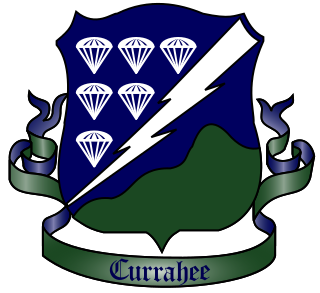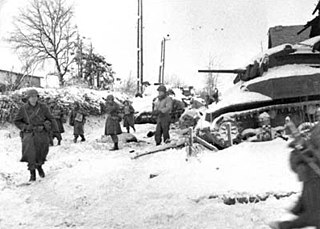
A paratrooper is a military parachutist—someone trained to parachute into an operation, and usually functioning as part of an airborne force. Military parachutists (troops) and parachutes were first used on a large scale during World War II for troop distribution and transportation. Paratroopers are often used in surprise attacks, to seize strategic objectives such as airfields or bridges.

Airborne forces are military units set up to be moved by aircraft and "dropped" into battle, typically by parachute. Thus, they can be placed behind enemy lines, and have the capability to deploy almost anywhere with little warning. The formations are limited only by the number and size of their aircraft, so given enough capacity a huge force can appear "out of nowhere" in minutes, an action referred to as vertical envelopment.

Operation Tonga was the codename given to the airborne operation undertaken by the British 6th Airborne Division between 5 June and 7 June 1944 as a part of Operation Overlord and the D-Day landings during the Second World War.

The Dirty Dozen is a 1967 American war film directed by Robert Aldrich, released by MGM, starring Lee Marvin. The picture was filmed at MGM-British Studios and features an ensemble supporting cast including Ernest Borgnine, Charles Bronson, Jim Brown, John Cassavetes, Robert Ryan, Telly Savalas, Robert Webber and Donald Sutherland. The film is based on E. M. Nathanson's novel of the same name that was inspired by a real-life group called the "Filthy Thirteen". In 2001, the American Film Institute placed the film at number 65 on their 100 Years... 100 Thrills list.

The 506th Infantry Regiment, originally designated the 506th Parachute Infantry Regiment during World War II, is an airborne light infantry regiment of the United States Army. Currently a parent regiment under the U.S. Army Regimental System, the regiment has two active battalions: the 1st Battalion, 506th Infantry Regiment is assigned to the 1st Brigade Combat Team, 101st Airborne Division, and the 2nd Battalion, 506th Infantry Regiment is assigned to the 3rd Brigade Combat Team, 101st Airborne Division.

In military organizations, a pathfinder is a specialized soldier inserted or dropped into place in order to set up and operate drop zones, pickup zones, and helicopter landing sites for airborne operation, air resupply operations, or other air operations in support of the ground unit commander. Pathfinders first appeared in World War II, where they served with distinction, and continue to serve an important role in today's modern armed forces, providing commanders with the option of flexibly employing air assets.

44 Parachute Regiment is the South African Army's chief airborne infantry unit. It was created in 2000 by redesignating 44 Parachute Brigade, and is based at the Tempe military base near Bloemfontein.

The Pathfinder Platoon is a pathfinder unit of the British Army, and an integral part of 16 Air Assault Brigade. The Pathfinder Platoon acts as the brigade's advance force and reconnaissance force. Its role includes locating and marking drop zones and helicopter landing zones for air landing operations. Once the main force has landed, the platoon provides tactical intelligence and offensive action roles for the brigade.

The maroon beret in a military configuration has been an international symbol of airborne forces since the Second World War. It was officially introduced in 1942, at the direction of Major-General Frederick "Boy" Browning, commander of the British 1st Airborne Division. It was first worn by the Parachute Regiment in action in North Africa during November 1942. Although coloured maroon, the beret of the British Parachute Regiment is often called the "red beret."
The Regimento de Paraquedistas, based in Tancos, Portugal, is a unit of the Portuguese Army and serves as the instruction center for recruitment and training of the Portuguese paratroopers. This unit includes an entire battalion, acting as support and reserve for Airborne units which contains for example, military war dogs and Airborne Pathfinders and an instruction battalion responsible for the forming of new paratroopers.

The Douve or Ouve is a river, 79 kilometres in length, which rises in the commune of Tollevast, near Cherbourg in the department of Manche. Ouve is considered its old name : Ouve appears to have been misspelled over the course of time as "Douve river" and then as "River of the Douve". The French name for this watercourse is la Douve.

44 Parachute Brigade was a parachute infantry brigade of the South African Army. It was founded on 20 April 1978, following the disbandment of 1 SA Corps. Upon formation, the brigade was commanded by Brigadier M. J. du Plessis, who was assigned the task of establishing the unit with the assistance of the Parachute Staff Officer, Colonel Jan Breytenbach. At the time du Plessis was the commanding officer of the Orange Free State Command and had previous experience serving in 1 Parachute Battalion. Breytenbach had also been a member of 1 Parachute Battalion and had also founded the South African Special Forces Brigade and 32 Battalion. The location that was chosen for the brigade's headquarters was in the lines of the OFS Cmd Headquarters, next to the old Tempe Airfield in Bloemfontein.

The Battle of Merville Gun Battery occurred on 6 June 1944, as part of Operation Tonga, part of the Normandy landings, during the Second World War. Allied intelligence believed the Merville Gun Battery was composed of heavy-calibre guns that could threaten the British landings at Sword Beach, only 8 miles (13 km) away.

1 Parachute Battalion is the only full-time paratroop unit of the South African Army. It was established on 1 April 1961 with the formation of the Parachute Battalion. After 1998 this unit was renamed to Parachute Training Centre. It was the first battalion within 44 Parachute Brigade until 1999 when the brigade was downsized to 44 Parachute Regiment

The 44 Pathfinder Platoon is part of the 44 Parachute Brigade. The pathfinder is a trained and specialized soldier who performs covertly behind enemy lines, either in small groups or in collaboration with other reconnaissance units.

Jack Neitz Womer was a decorated American World War II veteran and a member of the Filthy Thirteen who was known for his World War II exploits. Womer was a member of the 29th Ranger Battalion, the 101st Airborne Division and the 506th Parachute Infantry Regiment.

Richard E. Killblane is an American military historian and author. He has served in the U. S. Army as an enlisted man, an officer and a Department of Army civilian. Killblane is a veteran of Central American counter-insurgency and Operation Just Cause. He currently serves as the Command Historian of the U.S. Army Transportation School at Fort Lee, Virginia and has traveled extensively in Iraq and Afghanistan to research convoy operations. He has published numerous articles and books on military history and is considered an authority on military convoy security. In 2003, Killblane co-authored The Filthy Thirteen: The True Story of the Dirty Dozen detailing the life and World War II 101st Airborne Division exploits of Jake McNiece.
The Namibian Special Forces is a special operations command of the Namibian Defence Force responsible for special forces and special operations capable units. The command consists of Army commandos, Army Airborne paratroopers and the Marine Corps amphibious special operations unit. The Army commandos specialise in airborne and land borne insertion while the Marine Corps amphibious special operations unit specialise in small-unit maritime operations that originate from a river, ocean, swamp and delta. The army units receive training assistance from former South African Special Forces (Recces) and the marine corps from the Brazilian Marine Corps. The units regularly participate in Southern African Development Community (SADC) special forces exercises.




























